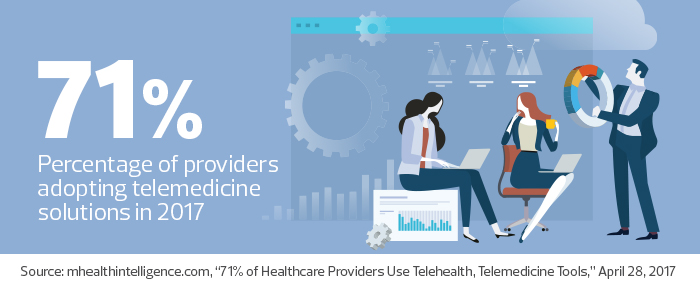How to Build a Foundation for Telehealth Success
Telehealth, and the broader field of digital health in particular, is complex yet rapidly evolving. Provider adoption of telehealth, for instance, continues to grow at a steady pace, from 54 percent in 2014 to 71 percent today, according to HIMSS Analytics.
Organizations looking to start their own telehealth program must approach the effort thoughtfully. Leading organizations are constantly adapting to the current fast-moving marketplace, mindful of fundamental building blocks including accountability, strategy, workflow integration, support and education.
Massachusetts General Hospital considered these principles in 2011 as the organization began its enterprise investment in telehealth. Its efforts range from video-enabled visits with patients inside their homes to remote second opinions for patients worldwide.
SIGN UP: Get more news from the HealthTech newsletter in your inbox every two weeks!
Establish Accountability and Strategy for Telehealth Programs
Pioneering organizations put resources into telehealth long before most knew what telehealth was. Accountability for telehealth was often placed with IT, with ultimate accountability to the CIO. As telehealth services have matured, many organizations have successfully realigned (or co-aligned) reporting and function to executives accountable for strategy and operations, such as a COO or a chief innovation officer.
Strategic ownership of telehealth tells stakeholders that it is not just another technology, but rather a fundamental change in care delivery. Leadership buy-in and vocal support are essential for resource prioritization.
Meanwhile, the extent to which telehealth may provide enterprise support of an organization’s strategies is tied to both resourcing and maturity of the program. In today’s constrained environment, it is tempting to spread resources in a broad and shallow manner, rather than deeply and narrowly. Health systems variably use telehealth to increase access, attract new patients, improve patient outcomes and reduce the total cost of care. However, if there are too many priorities, the boots on the ground will be challenged to implement and demonstrate impact and value.
The telehealth programs gaining the most momentum, though, are those rooted in a singular underlying strategy, such as improved value, patient engagement or new business development. Tenacious alignment of organizational strategy with a narrow focus will lead to a more effective program.
Remote Options Make Way for Workflow and Support
Telehealth technology has introduced the surprising workflow benefit of helping providers stay in the mental flow of patient care.
At Massachusetts General, providers across 15 clinical departments use two-way videoconferencing tools to enhance workflow in a variety of ways. Such technology allows doctors to simply click in and out of encounters with different patients at the same workstation, rather than interrupt their patient care flow by constantly logging on and off the electronic health record while walking between the clinic room and waiting area.
This helps doctors to mentally stay in the flow of visits. Additionally, videoconferencing technology enables providers to conduct visits from an administrative office, or even from home, opening valuable in-person space for other patient appointments. It also gives doctors a window into a patient’s home environment. Investigating the potential workflow impacts of such tools prior to deployment is critical.
Tap User-Friendly Support
Even one poor telehealth experience for a patient or provider is one too many. Telehealth must be easy to use and facilitate a seamless experience between the patient and provider. When technical challenges arise, it is essential to provide timely support and customer repair for an organization to ensure continued patient acceptance.
In the early stages of implementation, consider short-term centralization of activities that are not routine, such as in-person training, around-the-clock virtual or in-person technical support for providers and community hospital clients, or test calls to ensure patients are ready for an upcoming visit with their provider.

As programs mature, adoption increases and telehealth workflows are built into daily clinical operations, support can naturally evolve to a more decentralized model that mirrors the organization’s support approach for other enterprise tools such as phones and computers. Decentralizing some support is essential for achieving telehealth program scale. For example, in-person provider training could be transitioned to an on-demand online module, and a train-the-trainer approach could help equip local resources with the knowledge needed to buoy the most common technical support issues.
Prioritize Telemedicine Education and Training
At the root of the issue, tomorrow’s providers must be educated today to achieve adoption and sustainability. The reticent provider’s rebuff that “my patients aren’t ready for telehealth” will be self-perpetuating. If the provider isn’t ready, the patient won’t be ready either.
In healthcare, patients generally are deferential to a provider’s recommendations, including the appropriateness of telehealth. However, patients are ready for their care to catch up to their digital experiences with transportation, finance, commerce and entertainment.
Feedback from providers that “this isn’t how I was trained” gets to the heart of the issue. Clinicians in training must be exposed early and often to traditional in-person and virtual options for preventive care, diagnosis and treatment. Train tomorrow’s doctors for the evolution of clinical practice that the accelerating pace of change requires.
Incorporate a broad array of digital health approaches, including telehealth, into clinician training, and stay tuned for a profound and cascading impact on provider acceptance, patient engagement and the sustainability of the healthcare system.
There is currently a timely opening to impact both the care system and the future of health and wellness. The challenge and opportunity is to embrace the ambiguity, and incorporate lessons learned and patient-centeredness at every step along the way.









